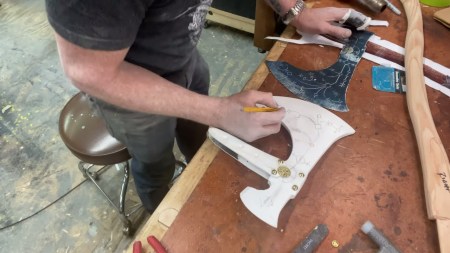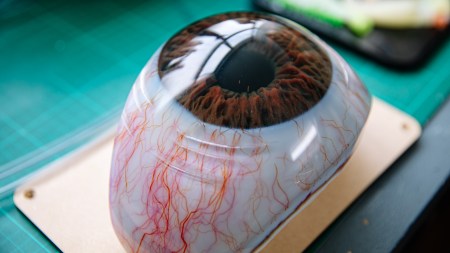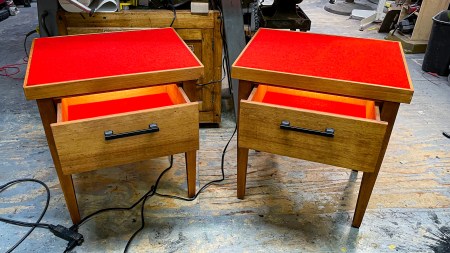One Day Builds
Adam embarks on one of his most ambitious builds yet: fulfil…
Show And Tell
Adam recently completed a build of the royal St. Edwards cro…
Making
Viewers often ask to see Adam working in real-time, so this …
One Day Builds
Adam and Norm assemble a beautifully machined replica prop k…
One Day Builds
One of the ways Adam has been getting through lockdown has b…
Making
Adam unboxes and performs a quick test of this novel new hel…
Making
When Adam visited Weta Workshop early last year, he stopped …
One Day Builds
Adam tackles a shop shelf build that he's been putting off f…
Show And Tell
Time for a model kit build! This steampunk-inspired mechanic…
One Day Builds
Adam reveals his surprise Christmas present for his wife--a …




































































Totally Unacknowledged for my great question!
Thanks guys I really appreciate it.
You guys are opening up a huge can here if there are as many “real” chefs here as makers. With knives since you started out there and I might come back to other topics later but with knives… If you are reading this and are thinking about getting a knife for the kitchen start out with a “Chef’s Knife” <-- Google it. A Chef's knife is your standard everyday knife and they are like cars, there are many makers some useful some flashy and on both ends of the price spectrum.
I suggest going to a cutlery store if you have that luxury or a bed bath and beyond and actually holding the knife you are looking to buy in your hand. Pretend to chop with it like you would IRL. You want to make sure that a knife feel good in your hands before you worry about if they knife is pretty, what the price is, or whom crafted that knife. Personally I love the butchers standard of Forschner Knives. If you are just starting out I would suggest getting an 8 inch knife blade. Sometimes bigger is not always better. Forschner knives are very simple but you can get them with rosewood handles and that is what I prefer over the newplastic. These knives are very easy to keep sharp, resharpen, and hold an edge for a long period. On that note of the edge, you are going to want to get a hoaning steal <--- google that. It is NOT... I repeat NOT a sharpener, but will help you keep and edge on your knife between sharpenings.
Forschner Knives. If you are just starting out I would suggest getting an 8 inch knife blade. Sometimes bigger is not always better. Forschner knives are very simple but you can get them with rosewood handles and that is what I prefer over the newplastic. These knives are very easy to keep sharp, resharpen, and hold an edge for a long period. On that note of the edge, you are going to want to get a hoaning steal <--- google that. It is NOT... I repeat NOT a sharpener, but will help you keep and edge on your knife between sharpenings.
When I am off work I will leave more comments on this section but you started to talk about knives.
Forschner Knives – 8 inch Chef’s Knife
So, on the tempura note, one thing I recently learned, and was directed to from Americas test kitchen is using vodka it works surprisingly well.
Another simple gadget, that’s really a cleanup thing, is to get some drain covers for your sink. Honestly, cleaning out our double sink is a pain. On one side it’s filled with goop I can’t let go down the drain, and the other is a disposal that always has some sort of kitchen item in it. We broke the plunger from our brand new cuisinart on day 1 because of that. I have a few spoons that are worse for wear. I have something cheap in there now, but I’m excited to get these guys.
On the note about a peeler. My NUMBER ONE suggestion is the Star Peeler, Made is Switzerland. Don’t buy a ripoff product of one of these. You can get one of these on ebay for $6. I have been working full time in kitchens for 17 year. I have had one of these peelers for 12 years. It is still sharp enough to fillet you finger during use. I keep getting my coworkers to buy them for themselves and I’ve never heard a complaint about this peeler.
If not for shits and giggles, just go buy one.
Garlic press.
I’ve spent this whole episode staring at that red Zojirushi mug, and I wanted Will to mention it.
My wife has that same mug in blue and with a tea filter insert, and she loves it.
Yes Adam, listen to the radio shows. The BBC sells a well-priced set on CD. And yeah, Moore is a lot more grumpy with companies (with good reason) and sycophants (with good reason) but neither of those are the fans.
He’s talked about it in the past, there’s an article on thewirecutter.com and or thesweethome.com about it
Thanks. It isn’t exactly a kitchen gadget, but they are very useful.
While they cannot stay in the oven, a great thermometer for the price — made by the same folks as the thermapen, is a thermo-pop which is retailing for around $24. Insta-read thermometer at the push of a button. Really great for double checking your temps or for cooking cuts of meat that it’s hard keep a probe in.
you can listen to these BBC radio shows on grooveshark as well.
I second Evernote as a recipe book. My wife and i have a shared notebook with stuff we’ve pulled off Epicurious, etc. No iPads, but we can have 2 different laptops open at different stations while we prep.
So, potentially controversial, but I found the tools pages of _The 4-Hour Chef_ interesting and informative, if not necessarily the exact right fit for the cooking I do. I’ve become a huge fan of the thin, flexible plastic cutting boards, however. And the recommended OXO 5lb digital scale is really nice.
garlic press, really? Its a one trick pony and a sharp knive or a small grater on occasion works just as well for me.
Next One day build: baking steel with grease trap. Please?
Good to know.
good write-up on entry kitchen knives! (except the typo on “honing steel” that could have thrown a curious reader off, back when search engines weren’t smart enough to show us what we want to see, even if we misspelled it)
i’d have only a small addendum, not for the total beginner who only wants a serviceable tool and live carefree from there, but rather the beginner who can see himself becoming somewhat invested: non-stainless steel is worth a consideration.
this comes from the same place as suggesting an opinel as a good pocket knife – even as a first pocket knife for kids who can be trusted with good tools. there is a little more maintenance involved, but as i see it, you have to do with a carbon steel knife what you should be doing with stainless steel knives anyway, so it is a means to enforcing basic good habits. if you don’t specifically need stainless, you can get a knife that sharpens easier and holds a much better edge. “rusty” carbon steel often has this reputation for being enthusiasts’ stuff, but i’d rather see it as something everyone can use. it’s not just stainless with the disadvantage of rusting, it’s an overall better steel than stainless that can easily outperform it under normal care conditions. it just doesn’t have stainless’ specific safeguard against rusting.
Adam, you spoke of a recipe which called for X number of cups of an ingredient or X number of ounces, and you said they were different quantities. The author should have been more clear, but could it be the recipe was calling for ounces by weight rather than volume, as a cup measure? Example, a cup of regular table salt weighs more than a cup of kosher salt.
So, uhhmm, yeah… that was great. 😊
thank you for the spelling correction. I was typing fast and just slipped up.
Also I do agree about carbon steel. I have a few of them but my knife chest is large. I was speaking from a just starting out standpoint. I think knife care and maintenance should be learned first before investing in a more expensive blade though.
The pro-chef book from The Culinary Institute of America is a great kitchens basic book full of technique skills and recipes for any beginner. The latest addition will run about $80 but the older additions are great and a lot cheaper.
And Opinel make kitchen knives too though think their entire range is stainless. For inexpensive carbon steel knives could look at Old Hickory. https://ontarioknife.com/cutlery/old-hickory . Though carbon isn’t going to be for everyone, some seem to worry about patinas.
yay! i was half-expecting a ton of flak. carbon steel is a bit of my personal crusade, so i might be a little overzealous there. 😉
that said, i do believe in carbon steel blades as learning tools. mainly because even a cheap-o stainless alloy blade will be somewhat serviceable without any care at all, whereas a carbon steel blade will both suffer under gross neglect and be very clear in its feedback to sharpening and honing. it is easier to mis-sharpen, but just as easy to bring back up to speed again. it will stay perfectly serviceable with minimal care, and SHINE when things start to click.
i agree, though, there probably is some merit in learning this with a low-investment blade. i am not familiar with prices in the US, but an opinel knife won’t set you back much more than 10 bucks, will it? my current pocket knife is a small higonokami knife that was about 20€, but has a tri-laminated blade of an aogami (“blue steel”, hardened to about 60 HRC) cutting layer sandwiched between milder steel. i’d recommend both options for the learning benefits i mentioned, and to get people hooked on the joy of a sharp knife. 🙂
for learning to sharpen by hand on a stone, i’d tend to prefer the higonokami, as its japanese blade geometry with its large, flat bevels provides good feedback on whether you are holding the blade at the right angle, with the entire bevel in contact with the stone.
EDIT
thanks for the link! there are some pretty knives there, and affordable, too.
as for patinas, i see the reservations one could have. to provide some perspective: my everyday pocket knive doesn’t get much more attention than not letting gunk from whatever i cut with it on the blade before i put it back in my pocket, and some finger oils from handling it. my outdoors knife is a hand-forged (most likely from some old lorry spring) khukri that gets one cleaning back home after a camping weekend, and an ever so slight wipe of oil before putting it away. i curse every time because all the dried sap and stuff would have been easier to clean off right away. 😉 anyway, that is enough for both of them to remain completely clear.
i recently found an old opinel that i thought i’d lost a few years ago. i won’t lie, that one looked pretty bad. 😉 but even for kitchen knives, if you have a basic routine of cleaning them after use, and making sure they are dry, i don’t see how such a daily use item could develop a patina.
A bench scraper, a knife/scissor sharpener, an ABC-level fire extinguisher (the only uni-tasker), a squirt bottle with a mix of bleach and water for cleaning up (especially after chicken or seafood) and baking racks are also good to have. For books? Eh, you can get away with a lot but I have close to two dozen that run the gamut of ‘beginner’ to ‘you’ll use this book once in your life and you’ll be happy you did’.
Per the thought of cook books I’d like to suggest “Joy of Cooking”. Really great for basics and standards, easy to follow and methodical. The recipes are great references to build upon upon. It was written for beginners and revered by the seasoned and professionals. Maybe worth note supposedly Julia Child’s first cook book.
Also cheap, super cheap. Can pick up for under 5 bucks for older versions at antique stores.
Agree with a lot of the gadgets and necessities in the podcast. We use the America’s Test Kitchen/Cook’s Illustrated online subscription a lot. It is really worth it to us because we use it for at least 2-4 meals a week. I just want them to release an iPad app now.
We’ve also become obsessed with the GIR spatula. I totally missed the kickstarter but we ordered one and then promptly ordered another and then they released more sizes and we ordered one of each. We use the standard size for damn near everything. Heat resistant, no seams for food to get stuck in, great balance of stiffness and flexibility. Really a perfect spatula.
Even more colors on the site.
Every time I go to Japan I come back with more knives; love what they do with carbon steel.
I really like the new white ceramic coated style non-stick pans.
I’m really pleased with the footage you guys put out, such a wide variety of topics discussed. I’ll be renewing my subscription for sure.
Also, I make wooden cuttings boards (and other cool things) as a hobby/part of my business… and they’re on etsy too. 🙂 http://www.etsy.com/shop/designableco
Until August 31, 2014 – * 15% OFF to Tested Members, use code TESTED15 at checkout. *
re: deep frying– with the oil temp approaching 400 degrees F, when you plunge the food into the oil you should hear a nice >KUSHHHHHHHH< and see enthusiastic roiling/boiling around the food. The oil is searing the outside of the food. This lets the heat of the oil cook the food, and the seared layer is preventing the grease from soaking into the food! Makes all the difference between soggy, greasy French Fries and nice, crisp ones.
I worked at a hotdog stand for several summers, and the french fries were usually frozen or nearly so. When we loaded the basket over the deep frier some frost or water would drip into the hot oil. When it made a somewhat musical-gurgley sound that was another indication that the oil was close to cooking temperature. But never put a glob of water in the hot oil; that can be sputtery dangerous!
–Paul E Musselman
I vote for a microplane grater. Super useful for citrus zest, ginger & garlic, nutmeg, parmesan cheese. Also fingertips if you’re not careful (so be careful).
Also, a good hand-cranked pasta maker is great if you’re into fresh pasta. You can roll the dough by hand, but it’s a lot of work. I had an el cheapo pasta maker that I used so much, the gears eventually wore down to nothing, so I’m now the happy owner of a beautiful Marcato Atlas machine.
Everyone seems to have their own preference when it comes to peelers. I myself prefer the basic Fiskars peeler:
And speaking of Fiskars; every kitchen needs at least one good pair of scissors, and for me there’s no better choice than the good old orange handled Fiskars general purpose scissors:
And couple of final items I should mention: In addition to the pans and skillets mentioned by Adam, I really love a good Wok, there doesn’t seem to be any limits to what you can prepare with one.
And for ease of use I just love the OBH Nordica Supreme Steel series of pots and kettles that allow you to poor the water out without the risk of dunking your potatoes/pasta/rice/… in the sink, even by using just one hand.
You and Adam are always looking for good books to read. On the subject of kitchens I have my top books not including the $800 Modernist Cuisine Book.
1: Julia Child’s – Joy of Cooking
2: On Food and Cooking: The Science and Lore of the Kitchen – by Harold McGee
3: The Meat Buyers Guide – This book will teach you about every cut of meat imaginable including breakdowns. This book is like the bible of meat and butchery
4: The Pro Chef: From the Culinary Institute of America (Any Addition will work honestly)
5: Salt: A world History – Mark Kurlansky
These would be my top 5 books. There are so many, but these are my top 5.
Also Restaurant supply stores are not always more expensive. Sheet pans for instance… I will only use restaurant supply sheet pans. They are usually $5 a piece for half sheets (these will fit in normal home ovens). They are so much better then department store sheet pans.
As sicnic said, a fire extinguisher is mandatory.
On cutting boards and meat, there is a sciencey reason why wood is actually better:
And I still like the old checkerboard and Fannie Farmer recipe books. They might seem obsolete compared to google but there’s a certainty to those books that google can’t give you. On that subject, there’s a cool Alton Browncast about cookbooks worth listening to (also, most Browncasts are worth listening to anyway).
True, but the noteworthy part is cleaned manually. I don’t know about you, but the thing I love about plastic cutting boards is that you can just throw them in the dishwasher and have them as good as new when they come out.
So, apparently you can apply the “Harbor Freight” methodology to kitchen gadgets as well.
http://www.harborfreight.com/heavy-duty-french-fry-cutter-66473.html
Adam already has a copy of Salt in “The Talking Room” – you can see it here in this screen grab from his interview with Tom Sachs:
And I agree with you, Salt is a fascinating read.
And yes, before anyone goes there, I do frequently pause Talking Room videos if only to virtually browse Adam’s bookshelves. It is in no way different than fans/prop builders who take screenshots in order to clarify details of items that they are building.! 🙂
In fact, I made mention of it in one of my comments from the David Chang interview and Will and Adam riffed on this subject in the podcast where they talked about a film history book on Adam’s shelf that another viewer inquired about.
I would absolutely love to see a podcast dedicated to a tour of this room. Please, please please!
Sorry about the multiple posts – please delete the extras – my browser was flaking out and telling me that a posting error occurred so I tried several times! 🙁
I’m surprised my most essential kitchen tool (besides the obvious chef’s knife, pans, and cutting board) wasn’t mentioned in the podcast nor these comments. A good pair of tongs. I use them for nearly every task in the kitchen.
As for books on cooking, I’d recommend Harold McGee’s On Food and Cooking.
My favorite tool are my pair of carbon steel knives. Had them made for me a year ago from a guy in Ashland Oregon. 8″ x 2.5″ and 1″ x 4″. Easy to sharpen and care for, and carbon steel is such a pleasure to work with. I have Madrone wood handles. They are lightweight and reasonably priced. I was leery about ordering at first, but after we talked on the phone, I did not hesitate to get some fine tools for myself. I can do all I need to do with these sizes.
asks the best damn questions, which is super rare. Kudos to you, Norm!
Speaking of seasoning pans, this is the best method I have ever found for seasoning cast iron. I have no affiliation with this blog or anything of the sort. It calls for using organic flaxseed oil and breaks into the chemistry behind it.
http://sherylcanter.com/wordpress/2010/01/a-science-based-technique-for-seasoning-cast-iron/
IF you want a very good cook book try this
http://www.amazon.co.uk/River-Cottage-Veg-Every-Day/dp/1408812126/ref=sr_1_1?ie=UTF8&qid=1404944488&sr=8-1&keywords=river+cottage
His shows are also amazing. There are a couple of them on Youtube worth checking out. The one where he breaks down an entire pig into different meals and preserved foods comes to mind.
I’m not a vegetarian, but I wish to some day be able to eat meat like this guy does.
In re: knives. It pains me when I drop in at a friend’s place and I see they’ve spent hundreds(!) of dollars on the most expensive knives they can find, only to learn they barely use most of the set. I came across these at my local resto supply place
http://www.mercercutlery.com/professional-cutlery/millennia%E2%84%A2-color-handles
that I recommend to people who ask me about what they should get for knives. These are circa $20-30 each, and they hold an edge very well. They’re colour-coded for HACCP purposes (green for veg, red for for meat, yellow for poultry, etc.) too. I have a few of these in the 8-inch chef’s knife and 7-inch santoku patterns and they’re my go-to knives.
Not, strictly speaking, to do with kitchen equipment, but your discussion regarding the magazine at the start of the podcast (I’ve forgotten it’s name, I’m afraid!), reminded me of the “How to cook to perfect…” column written by Felicity Cloake on the Guardian website.
Each week she picks a particular dish, conducts a review of and cooks from published recipes for that dish, and then comes up with her recommendation for the ‘perfect’ version of the dish by drawing from those recipes (and her own experience). I think she’d probably be the first to admit that it’s her own particular version of ‘perfect’, but the final product invariably looks amazing, and I’ve learned a lot about the why when it comes to variations in recipes, which I think helps a lot with my cooking generally.
I guess I should probably point out that she’s a British chef writing for a British paper, so her recipes contain ‘gram(me)s’ and ‘gas marks’, and don’t go in for ‘cups’ very much.
PS She also wrote the first Leon cookbook, which I’d recommend too.
Wow, no mention of coffee gear!
I didn’t realise they didn’t talk about coffee until you mentioned it….. Definitely a missed subject.
Great episode, only two (major) disagreements.
No, no, no! You NEED thick bottomed pots, especially, to prevent burning. This is especially true for things like soup. We got TWO sets of the Emeril cookware, which has nice thick bottoms. (*coff*)
And I believe you dearly underrate the value of a stick blender. I’m glad you brought it up, but they’re extraordinarily useful for nearly everything a regular blender can do, but without (a) pouring hot soup out of your pan and burning yourself, nor (b) dirtying yet another vessel.
Good job Adam on discovering the value of passers (he called them screens) for making super-smooth soup.
I cannot believe nobody mentioned or has a Thermomix. We use ours every day and it has replaced our mixer, juicer, scales, bread machine, blender, and steamer. I also use it to make Sous Vide eggs as it has excellent temperature control.
Since Adam makes so many soups, he should really look into it!
One thing noone’s mentioned yet: a good pepper grinder/mill. Fresh pepper is so much nicer than ground stuff. And a basic spice rack just to keep the jars organised and easy to reach.
Also handy to have: a splatter screen, to stop whatever you’re cooking from covering your stove and countertop in grease splatters without smothering it with a lid. http://www.amazon.com/s/ref=nb_sb_noss?url=node%3D3737171&field-keywords=&rh=n%3A1055398%2Cn%3A284507%2Cn%3A289754%2Cn%3A3737191%2Cn%3A3737171
I find garlic presses a nightmare to clean – just squash the clove with the side of a chef’s knife and chop it; there’s less waste and no extra clean-up.
Could we get a post with all the recommendations that you guys made (akin to the tested.com/toolkit)?
Save some dough and get Lodge cookware instead of Le Creuset. We have both and the Lodge is just as good.
“It’s a bit nutty!” Nice Austin Powers reference there.
My weird but useful kitchen tool is unscented waxed dental floss. I make home made New York style cheesecakes, and floss is the best way of cutting them. I haven’t tried it with regular cakes or other similar baked goods, but I wouldn’t be surprised to find it works just as well.
The Evernote Food app for the iPhone and iPad is also a great way to keep track of recipes and other food eaten.
Will you haven’t mentioned anything about a pizza stone! Great addition to any kitchen.
crock pot! so many entire dinners can be made by throwing ingredients into a crockpot and cooking it on low for the entire day while you’re at work.
Bartenders Friend is awesome! It will take baked on black burns off of stainless steel. We love our Bamix, Mandolin, VITAMIX (Hummus FTW!) and Spiralizer.
Do any of you have unique pantry stocking methods?
i have a pantry shelf in my basement that is too deep and about every 6 months i have to go through and see what has been forgotten and expired.
It is a 4’x2′ shelf system with 5 shelves that when i bought i thought was a good idea but so wasn’t.
i want to make a new setup and i’m just curious if any of you have done something that worked really well.
Thanks for helping out, good info.